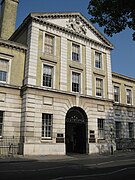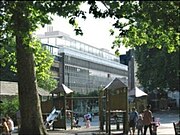University College London is a public research university in London, England. It is a member institution of the federal University of London, and is the second-largest university in the United Kingdom by total enrolment and the largest by postgraduate enrolment.
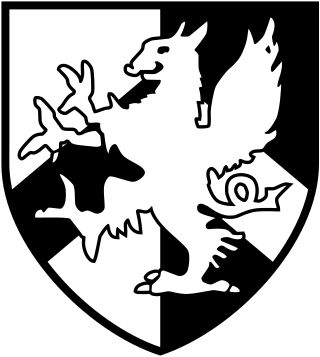
Barts and The London School of Medicine and Dentistry, commonly known as Barts or BL, is a medical and dental school in London, England. The school is part of Queen Mary University of London, a constituent college of the federal University of London, and the United Hospitals. It was formed in 1995 by the merger of the London Hospital Medical College and the Medical College of St Bartholomew's Hospital.
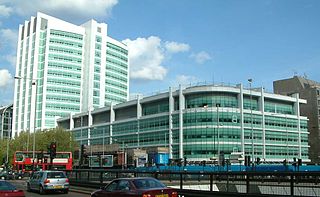
University College Hospital (UCH) is a teaching hospital in the Fitzrovia area of the London Borough of Camden, England. The hospital, which was founded as the North London Hospital in 1834, is closely associated with University College London (UCL), whose main campus is situated next door. The hospital is part of the University College London Hospitals NHS Foundation Trust.

Queen Square is a garden square in the Bloomsbury district of central London. Many of its buildings are associated with medicine, particularly neurology.

King Edward Medical University is a public medical university located in Lahore, Punjab, Pakistan. It was established as Lahore Medical School during the British Raj in 1860 and is named after King Edward VII.
The London School of Medicine for Women (LSMW) established in 1874 was the first medical school in Britain to train women as doctors. The patrons, vice-presidents, and members of the committee that supported and helped found the London School of Medicine for Women wanted to provide educated women with the necessary facilities for learning and practicing midwifery and other branches of medicine while also promoting their future employment in the fields of midwifery and other fields of treatment for women and children.
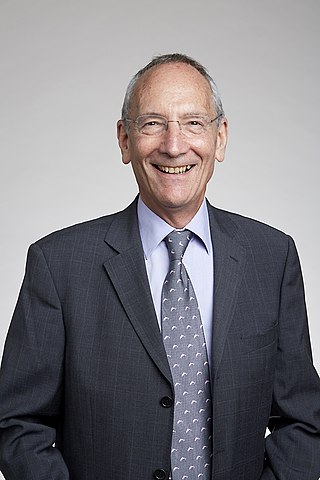
Stafford Louis Lightman has been Professor of Medicine, University of Bristol, since 1993. He was president of the British Neuroscience Association 2017–2019.

John Michael Newsom-Davis was a neurologist who played an important role in the discovery of the causes of, and treatments for, Myasthenia gravis, and of other diseases of the nerve-muscle junction, notably Lambert–Eaton myasthenic syndrome and acquired neuromyotonia. Regarded as "one of the most distinguished clinical neurologists and medical scientists of his generation," he died in a car accident in Adjud, Romania, having visited a neurological clinic in Bucharest earlier the same day.

The Royal Free London NHS Foundation Trust is an NHS foundation trust based in London, United Kingdom. It comprises Royal Free Hospital, Barnet Hospital, Chase Farm Hospital, as well as clinics run by the trust at Edgware Community Hospital, Finchley Memorial Hospital, and North Middlesex University Hospital. On 1 July 2014, the Barnet and Chase Farm Hospitals NHS Trust was acquired by Royal Free London NHS Foundation Trust, making it one of the largest trusts in the country.

The Eastman Dental Hospital was based on Gray's Inn Road until it co-located with the University College London ear, nose, throat, balance and hearing services on Huntley Street, London, as the Royal National ENT and Eastman Dental Hospitals in October 2019. The hospital continues to provide specialist dental treatment as well as ear, nose, throat, hearing, speech and balance services and is part of the University College London Hospitals NHS Foundation Trust.
University College London Hospitals NHS Foundation Trust (UCLH) is an NHS foundation trust based in London, United Kingdom. It comprises University College Hospital, University College Hospital at Westmoreland Street, the UCH Macmillan Cancer Centre, the Royal National ENT and Eastman Dental Hospitals, the Hospital for Tropical Diseases, the National Hospital for Neurology and Neurosurgery, the Royal London Hospital for Integrated Medicine and the Royal National Throat, Nose and Ear Hospital.

Royal Free, University College and Middlesex Medical Students RFC is the rugby union club for UCL Medical School, which is part of the University of London. The rugby club is commonly referred to by its shortened name of RUMS RFC or RUMS Rugby. The club is registered with the RFU and plays in the traditional colours of the medical school: blue, yellow and black.

The UCL Great Ormond Street Institute of Child Health (ICH) is an academic department of the Faculty of Population Health Sciences of University College London (UCL) and is located in London, United Kingdom. It was founded in 1946 and together with its clinical partner Great Ormond Street Hospital (GOSH), forms the largest concentration of children's health research in Europe. In 1996 the Institute merged with University College London. Current research focusses on broad biomedical topics within child health, ranging from developmental biology, to genetics, to immunology and epidemiology.

Dame Parveen June Kumar is a British doctor who is currently Professor of Medicine and Education at Barts and The London School of Medicine and Dentistry. She worked in the NHS for over 40 years as a consultant gastroenterologist and physician at Barts and the London Hospitals and the Homerton University Hospital. She was the President of the British Medical Association in 2006, of the Royal Society of Medicine from 2010 to 2012, of the Medical Women's Federation from 2016 to 2018 and of the Royal Medical Benevolent Fund from 2013 to 2020. She was also Vice President of the Royal College of Physicians from 2003 to 2005. In addition, she was a founding non-executive director of the National Institute of Clinical Excellence, chaired the Medicines Commission UK until 2005, and also chaired the BUPA Foundation Charity for Research until 2013.
Sir Peng Tee Khaw is a Chinese-Malaysian British consultant ophthalmic surgeon at Moorfields Eye Hospital in London, specialising in adult and paediatric glaucoma.
Michael G Hanna is Director of the UCL Institute of Neurology, University College London and professor in clinical neurology and consultant neurologist at the National Hospital for Neurology and Neurosurgery, Queen Square, London, and also Director of the Medical Research Council (MRC) Centre for Neuromuscular Disease.
Paul Harmer Sandifer was a British medical doctor. He is considered one of the early founders of paediatric neurology in Great Britain.
Katharine Georgina Lloyd-Williams CBE was a British anaesthetist, general practitioner and medical educator. She was a consultant anaesthetist at the Royal Free Hospital from 1934 and dean of the Royal Free Hospital School of Medicine from 1945, retiring from both posts in 1962.
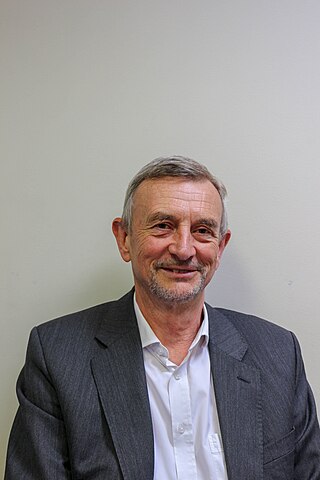
Martin Neil Rossor, is a British clinical neurologist with a specialty interest in degenerative dementias and familial disease.
Prof Clare Fowler CBE is a British physician and academic who created the subspecialty of uro-neurology, a medical field that combines urology and neurology. This work was done at the Institute of Neurology, University College London, where she is an emeritus professor.




